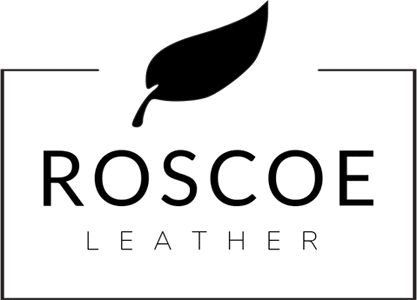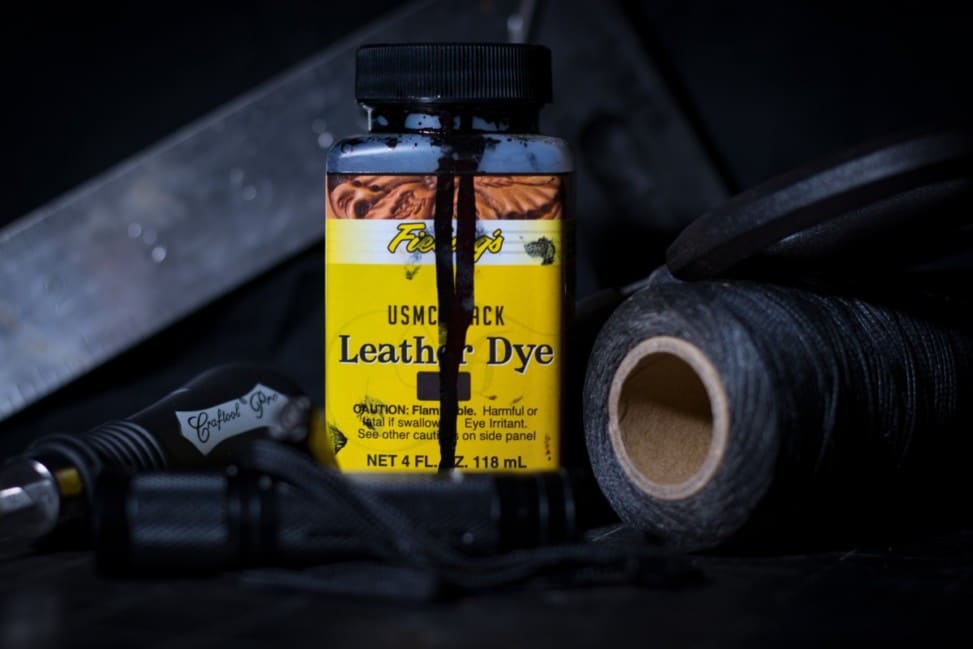In this post, we will cover the subject of leather dye as below:
- What is leather dye?
- Leather dye vs Leather Paint
- Types of Leather Dye
– Alcohol-based Dye
– Oil-based Dye
– Water-Based Dye - Which dye should I choose as a beginner?
What is Leather Dye?
Leather dye is a mixture of substances and dyes that are used for leather coloring. Basically, leather dye is one of the options that can be used to add colour to your project. You can use it on both the surface and edges.
Typically, leather dye are used with vegetable tanned leather. Vegetable tanned leather are available in the neutral and natural color, in which you can dye them to your desired color.
Other than vegetable tanned leathers, most leathers are not meant to be dyed. For example: If you are applying dye to a chrome tanned leather, the dye would fade off the leather because of the coating done during the chrome tanning process. I believe it would be difficult to apply an even and good coating as well. Typically chrome tanned leather are already coated and colored during the tanning process.
Leather Dye vs Leather Paint
First of all, dye is different from paint. In this topic, I will not debate the differences between the two. In short, the main differences are:-
- Leather Dye:
Penetrates and soaks into the leathers. Last longer. Colors are less vivid. Leather natural fiber and grains are still visible after applying dye. - Leather Paint:
Sits on top of the leather. Available in a lot of vibrant colors (Any color actually). It doesn’t age well and tends to crack over time. Paint tends to cover the natural fibers and grains of the leather once applied.
As a beginner, you would want to use dye. If the color you want to achieve is available in dye, by all means use dye. Else, paint will be an option.
Types of Leather Dye
Leather dyeing is very subjective to your own preference. It depends on the color you would like to achieve. Adding multiple coats will make the color darker while diluting the dye will allow you to get lighter or multiple shades of the color.
Commonly there are three types of dye which are:
Alcohol-based dyes
Alcohol-based dyes contain alcohol mixed with coloring substances. It is widely available and commonly used. It is also known as a solvent-based dye. After applying to leather, the alcohol evaporates and leaves the coloring substance inside the leather fiber. Due to the nature of alcohol, it tends to evaporate faster than water. Diluting alcohol-based dyes would require alcohol substances as well. Common diluting substances used are isopropyl alcohol, denatured alcohol, ethanol, and methylated spirits, etc.
Alcohol-based dyes are very harsh on the leather. It tends to make the leather harden and it will crack when it bends back. Since the drying phase is very rapid, the alcohol that evaporates tends to drag with it a part of the residual moisture of the leather, thus modifying the characteristics of softness, and very often drying the leather and making it stiffer.It dries our the leather more than other types of dye and sometimes causing the edges to curl.
The coloring substances are powder-based. Then the alcohol carrier sinks into the leather, it will leave a little bit of powder on the surface. This is rub-off. This is why very often leather items that have been colored with alcohol-based dye have problems of color rub-off.
Another thing about alcohol-based dye is the smell. It is as strong and pungent smell. Personally, I love the smell of leather thus I don’t use alcohol-based dye.
Features of an alcohol-based leather dye:
- Rapid penetration
- Quick drying
- Strong and pungent smell
- Low level of fiber impregnation
- Tendency to dry the skin
The common alcohol-based dye you can buy is Fiebing’s Leather Dye. It is Fiebing’s standard dye which are widely available in different colors.
Get Fiebing’s Leather Dye. Best Deal!
Being alcohol-based, you will need to oil the leather after it dries to potentially stop the cracking.
PRO TIP
Oil-based dyes
Firstly, oil-based dyes are actually alcohol-based. Oil dyes are commonly referred to Fiebing’s Pro Dye. It used to be named as Oil Dye, they changed it probably due to the confusion of the name. The oil refers to the oils in the dyes and colorants that create the colors but the base of the dye is a solvent like standard alcohol-based leather dye. The Pro Dye is being marketed as an “improved” version of the traditional alcohol dye. Thus, the higher price tag. (kindly take note)
Get Fiebing’s Pro Dye! Best Deal on Amazon!
I’m not 100% sure on the composition of the mixture but the reason it has “oil” in the name is because it contains oil-based substance in the colorants (opposed to the powder-based in the typical alcohol-based dye).
Alcohol-based dye hardens the leather, causing it to have the tendency to crack when bending. Oil dye solves this problem. The leather does slightly stiffen up but won’t crack when bending it.
The oil have better impregnation on leather, thus it doesn’t leave a rub-off like the powder-based dye.
Water-based dye
Contrary to alcohol-based dyes, the water-based dyes are made of a more complex mixture: usually in the formulation they include a resin (or a mixture of resins of acrylic or polyurethane origin): the resin guarantee the impregnation of the leather fibers and the coupling of the coloring substances to them. Moreover, in the formulation may be present additional components such as wax, grease or oils necessary for maintaining the softness of the leather or to increase some characteristics such as polishing.
The penetration of water-based leather dye is therefore more difficult and the drying time is slower than the alcohol based, but on the other hand this allows you to have a greater color bonding and maintaining the original softness of the leather.
Diluting water-based dye can be done by just adding water. There is no right formula for diluting. Diluting according to your desired color.
Features of a water-based leather dye:
- Slow penetration
- Slow drying
- No Smell
- Good color consistency
- Good resistance to color rub-off
- Maintaining of original leather softness
Common water-based dye you can buy is Tandy’s Eco-flo.
Best Tandy’s Eco-Flo Deal on Amazon!
Which dye should I choose as a beginner?
In my opinion, alcohol-based dye have better performance compared to water-based dye. This based on my own personal preference. Water-based dye tends to bleed when in contact with water. Water-based dye not have vibrant colors and it is tough to get an even application on leather.
Best deal on Amazon! Fiebing’s Pro Dye!
As a beginner, I suggest going with alcohol-based. Just get Fiebing’s Pro Dye if you have more budget. You can also opt for pre-dyed leather. Experiment around and see what works for you.
In the next chapter, we will talk about the types of burnishing agents used in leathercraft / leatherwork.
Leathercraft Basics – Table of Content
Chapter 1: Leathercraft Basics Introduction
Chapter 2: Understanding the Leathercraft Process
Chapter 3: Tools Needed for Leathercraft
Chapter 4: Leather Explained – Choosing The Right Leather
Chapter 5: Leather Dye (You are here)
Chapter 6: Burnishing Agents
Chapter 7: Adhesive / Glue
Chapter 8: Leather Finishes
Chapter 9: Leathercraft Techniques (Coming Soon)
Chapter 10: Machinery used in Leathercraft (Coming Soon)
Credit:
Featured Image by Two Paddles Axe and Leatherwork
Info source : GIARDINI





